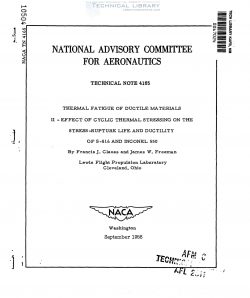naca-tn-4165
- Version
- 130 Downloads
- 2.27 MB File Size
- 1 File Count
- February 2, 2017 Create Date
- February 2, 2017 Last Updated
National Advisory Committee for Aeronautics, Technical Notes - Thermal Fatigue of Ductile Materials - II - Effect of Cyclic Thermal Stressing on the Stess-Rupture Life and Inconel 550

An experimental study was made of the changes in the stress-rupture
life, ductility, hardness, and microstructure of 8-816 and Inconel 550
specimens that had been exposed to varying amounts and conditions of
thermal fatigue.
Tensile specimens of 3—816 and Inconel 550 were alternately heated
and cooled while constrained in a manner that prevented their free axial
expansion and contraction. Before failure by thermal fatigue occurred,
the thermal cycling was discontinued so that the effect of the number of
cycles on the properties of the material could'be measured. The thermal
cycling covered a range of maximum cycle temperature, temperature dif-
ference in cycling, and cyclic exposure time at the maximum cycle
temperature. A few specimens were first run for short periods of time
in stress—rupture and were then failed by thermal fatigue.
Exposure to thermal—fatigue conditions strengthened 8—816 in stress
rupture and weakened Inconel'550. Under the most damaging conditions
studied, Inconel 550 lost 98 percent of its original stress-rupture life
as a result of prior thermal fatigue, even though the number of cycles
was only one-half of that required for failure by thermal fatigue alone.
The stress-rupture life of 5-816 was increased by about 50 percent.
When specimens were first exposed to stress-rupture conditions and then
run to failure in thermal fatigue, the thermal-fatigue life of 8-816 was
sharply reduced, whereas that of Inconel 550 showed a slight increase.
The results can be interpreted by extending existing theories of mechan-
ical fatigue and creep—rupture to thermal fatigue.
*The information presented in this report was offered by Dr. F. J.
Clauss as a thesis in partial fulfillment of the requirements for the
degree of Doctor of Philosophy in Metallurgical Engineering, University
of Michigan, Ann Arbor, Michigan, June 1957. Professor James W. Freeman
was chariman of Dr. Clauss' doctoral committee and is also a consultant
to the Lewis Flight Propulsion Laboratory.
| File | Action |
|---|---|
| naca-tn-4165 Thermal Fatigue of Ductile Materials - II - Effect of Cyclic Thermal Stressing on the Stess-Rupture Life and Inconel 550.pdf | Download |

Comment On This Post